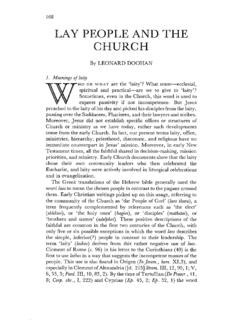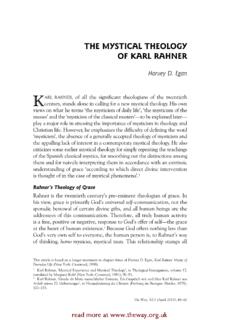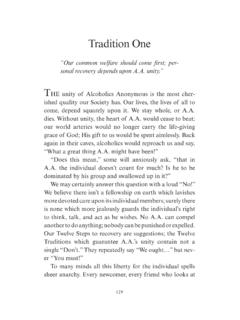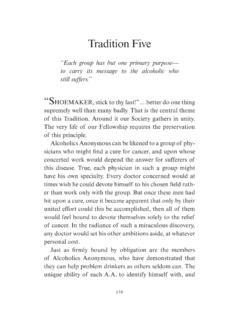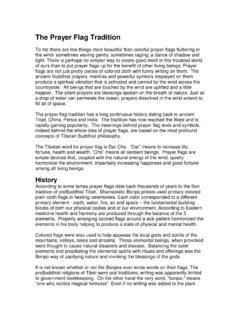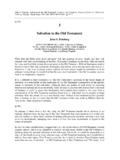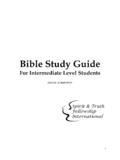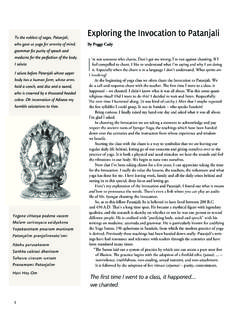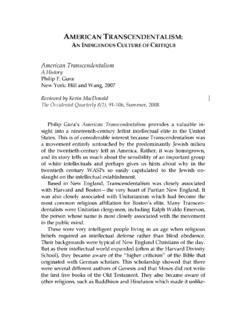Transcription of The robe of glory - The Way
1 247 The robe of glory A biblical image in the Syriac tradition Sebastian Brock The background 6 V'~ HE QUESTION OF THE RELATIONSHIP of the human person to clothing .t is basically not a moral concern .. but a metaphysical and theological one.' This statement, made by the author of a classic article entitled 'The theology of clothing', 1 may at first sight seem surprising, but it only needs a few moments' reflection to recall that there are numerous passages in both Testaments where clothing imagery is employed with reference both to God and to human beings; thus, for example, in the Old Testament God 'puts on righteousness' (Isai 59:17), 'is clothed in light' (Ps 104:2), and 'the Spirit of God clothed itself with Zechariah son of Jehoiada the priest' (2 Chr 24:20), while in the New Testament Christ tells the disciples they 'will be clothed in power from on high' (Lk 24:49) and the baptized 'have put on Christ' (Gal 3:27).
2 In the biblical literature, and in the ancient Near East in general, clothing is an expression of identity, and nakedness represents the loss of identity, z This is in sharp contrast to the Greek tradition , where nakedness reflects both an aesthetic and a philosophical ideal. Early Christianity was heir to both these traditions, and so not surprisingly both are well represented in the formative period of Christian literature. Writers influenced by Neoplatonism in particular would emphasize the 'stripping off' of the soul's 'garment' (whether this be the body, or the passions), while for those who remained closer to the biblical tradition what was important was that the garment should be the proper one.
3 The contrast between these two attitudes can be nicely seen in the exegetical tradition of the biblical narrative of Genesis 3. In what we may for convenience call the Greek approach, the Fall consists in the toss of a state of innocent nakedness and the consequent need for clothing (provided first by Adam and Eve themselves with the fig leaves, and then by God with the garments of skin, Gen 3:7, 21). The biblical (and Semitic) approach, on the other hand, sees the Fall as involving the loss of one garment - the 'robe of glory ' - and covering up of the resultant naked state by another, inferior, garment. This latter approach is to be found here and there among early Christian authors writing in Greek 248 THE ROBE OF glory and Latin, but it is best witnessed in Syriac literature where we find a highly imaginative use of clothing imagery in the context of theology) Indeed, as we shall see, the entire course of salvation history came to be described in terms of taking off and putting on clothing, starting and ending with the 'robe of glory '.
4 That there was to be a final 'garment of glory ' in which the righteous would be clothed was probably a fairly widespread idea by the time of Christ, and it appears most prominently in different parts of the Ethiopic book of Enoch, in particular at 62:15-16, 'the righteous and elect will have risen from the , and will be clothed with gar- ments of glory '. In the Syriac translation of Daniel it is interesting to find that Daniel's angelic interlocutor is described as wearing 'garments of glory ' (10:5, 12:7); in the Hebrew he is just clothed in linen). The exegetical roots of the tradition In the Hebrew text of Genesis 3 there is of course no mention of any 'robe of glory ' worn by Adam and Eve prior to the Fall, but in an early exegetical tradition , to which later Jewish midrashim and Syriac Christian writers were heirs, the verb in Genesis 3:21 was taken as a pluperfect, 'God had.
5 Clothed them', thus referring, not to the clothing of Adam and Eve after the Fall (as it appears in all modern translations), but to their original clothing, prior to the Fall. Furthermore, this clothing was understood as being not of 'skin' (Hebrew 'or) but of light ('or), or of glory (a translation reflected in part of the Targum tradition ). It may be that this tradition was already familiar to the Syriac translator of psalm 8, for in verse 6, where the Hebrew (together with Septuagint, Targum and Vulgate) has 'You made him a little less than the angels, in honour and glory did you crown him', the Syriac has altered this to '.
6 In honour and glory did you clothe him'. Given this tradition of both a primordial and an eschatological 'robe of glory ' (often also described as one 'of light'), Syriac writers ima- ginatively drew on this theme of the 'robe of glory ' to illustrate the different stages in the course of the entire span of salvation history. Since they rarely describe the entire scenario from start to finish, but prefer to allude to particular episodes while presupposing an awareness of the whole, it will be helpful to have in mind from the start the main stages of this drama of salvation, reduced to a schematic outline: - in their initial state in Paradise Adam and Eve are clothed in the robe of glory ; THE ROBE OF glory 249 - their disobedience of God's commandment not to eat of the Tree of Knowledge results in their loss of the robe of glory .
7 - a prime aim henceforth of divine providence is to provide human beings with a means by which they can recover the lost robe of glory . At the incarnation the divine Word thus 'puts on a human body', and at his baptism he makes the robe of glory available once again to humanity by depositing it in the river Jordan (seen as one of the fountainheads of Christian baptism, along with John 19:34); - at Christian baptism the baptized put on, in potential, the robe of glory ( when, in Pauline terms, 'they put on Christ'); - at the eschaton the robe of glory will be theirs in reality, provided they have preserved it unsullied during their lifetime.
8 As will emerge, this final stage is not just seen as a return to the primordial Paradise, for the eschatological Paradise is far more glorious. How do Syriac writers describe the course of this drama? In pro- viding an answer, use will be made in particular of the writings of the great fourth-century theologian-poet St Ephrem and of the liturgical texts of the various Syriac Churches. The primordial robe of glory and its loss Adam and Eve are understood both as individuals and as representing humanity in general; Adam is thus Everyman, and indeed sometimes not just every man, but every human being. The Genesis narrative is understood as having paradigmatic significance, providing an explan- ation for the state of flawed humanity in which we find ourselves.
9 At the same time, by describing what was, the Genesis narrative hints at what might be. Although the Syriac translation of Genesis 3:21, following the standard Hebrew text, has 'garments of skin' as the clothing provided by God after the Fall, Ephrem and other Syriac writers were also well aware of the tradition of Adam and Eve being clothed in a 'robe of glory ' prior to the Fall, despite the fact that they no longer had any awareness of the exegetical origin of this in Genesis 3:21. Thus, commenting on Genesis 2:25, Ephrem writes, reflecting the charac- teristically Semitic dislike of nakedness :4 It says 'The two of them were naked, but they were not ashamed'.
10 It was not because they were ignorant of what shame was that they were not ashamed .. It was because of the glory in which they were wrapped that they were not ashamed. Once this had been taken away 250 THE ROBE OF glory from them, after the transgression of the commandment, they were ashamed because they had been stripped of it, and the two of them rushed to the leaves in order to cover not so much their bodies as their shameful members. Yet, even though they had this raiment of glory , Ephrem goes on to explain that Adam and Eve were nonetheless created in an intermediate st ate: 5 Because God had given to Adam everything inside and outside Paradise through Grace, requiring nothing in return, either for his creation or for the glory in which He had clothed him, nevertheless out of Justice God held back one tree from For when God created Adam, He did not make him mortal, nor did He fashion him immortal.

